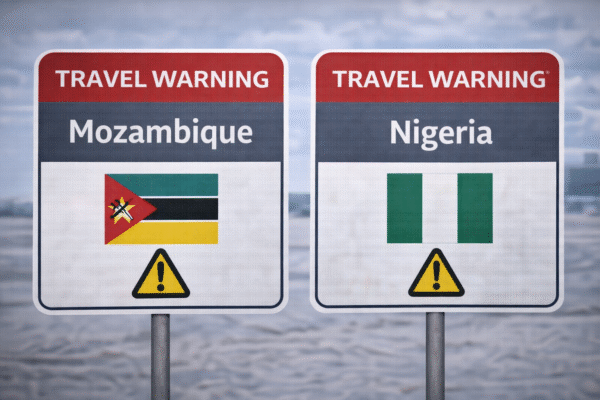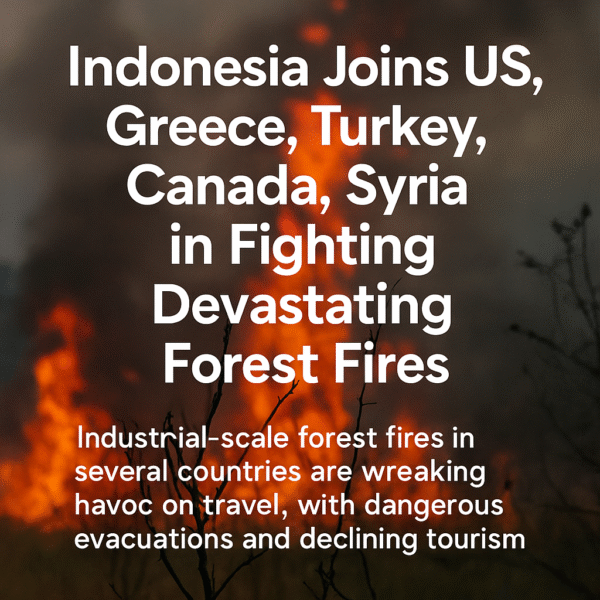Indonesia is now among the growing list of countries facing devastating wildfires, alongside the United States, Greece, Turkey, Canada, and Syria. As flames tear through forests and haze clouds the skies, the impacts are far-reaching — from environmental devastation to severe blows to tourism industries already recovering from years of disruption. With forest fires burning across Sumatra and other key Indonesian regions, the archipelago is experiencing air travel delays, eco-tourism setbacks, and economic strain — signaling a growing climate emergency for tourism.
Tourism Hit Hard in Riau, West Sumatra, and South Sumatra
Regions like Riau, South Sumatra, and West Sumatra — popular for nature-based travel — have been hardest hit by ongoing fires. Smoke pollution, known locally as asap, has worsened air quality in these provinces, leading to cancellations of outdoor tourism activities, flight disruptions at regional airports, and a noticeable dip in international arrivals.
According to Indonesia’s Ministry of Tourism and Creative Economy, tourist bookings in affected provinces dropped significantly between April and July 2025, with travel companies reporting cancellation rates as high as 45%. Eco-tourism sites in Riau, previously booming due to rainforest trekking and bird-watching, have seen a near halt in visitor traffic. Travel advisories issued by countries like Australia and Singapore warn of respiratory risks for travelers.
Worsening Climate Trends and Fire Management Challenges
Indonesia’s dry season, intensified by El Niño and exacerbated by global climate change, is driving more frequent and severe forest fires. The country’s Meteorology, Climatology, and Geophysics Agency (BMKG) reported over 500 hotspots across Sumatra in June 2025. Poor enforcement of land-clearing regulations and the widespread use of slash-and-burn practices in agricultural zones further contribute to the wildfire crisis.
The Ministry of Environment and Forestry has deployed thousands of firefighters, drones, and water bombing helicopters, yet containment remains challenging. As thick haze continues to affect air travel and daily life, tourism-dependent regions fear an extended recovery.
United States: Billions in Tourism Loss from California and Hawaii Fires
Across the Pacific, the United States continues to endure major wildfire damage. California’s 2024 fires caused tourism revenue losses estimated at $5 billion, according to Visit California. While total travel spending in the state reached $157.3 billion, hotspots like Yosemite and Napa Valley saw visitor declines due to road closures, hazardous air, and damage to natural landscapes.
In Hawaii, especially Maui, the recovery from the 2023 Lahaina fires is ongoing. Maui saw a 6% drop in total arrivals in 2024, and visitor spending dropped 23.3% to $2.19 billion compared to 2023. The rebuilding of Lahaina’s historical sites — a magnet for cultural tourists — remains slow.
Greece: Mass Evacuations and Plummeting Bookings in Rhodes and Crete
In Southern Europe, Greece’s wildfire emergency has pushed its tourism sector into crisis. July 2025 fires in Crete forced over 5,000 evacuations in tourist zones like Ierapetra. In 2023, Rhodes saw 20,000 tourists evacuated — many of them British nationals — prompting airlines such as TUI and Jet2 to cancel flights.
The European Travel Commission reported a 10% decrease in July bookings to Greece year-on-year, while the Hellenic Tourism Organisation is focusing on safety communications and green tourism to regain traveler confidence.
Turkey: Wildfires Threaten Muğla, İzmir, and Antalya Tourism Corridors
In Turkey, wildfires in Muğla, İzmir, and Antalya have decimated key coastal areas known for beach resorts and ancient ruins. Marmaris saw an 80% tour cancellation rate in summer 2025. Antalya — a tourism capital with 18 million visitors expected — welcomed just 7.5 million so far this year due to safety concerns and environmental degradation.
Local businesses tied to international tourism have appealed for government compensation. The Turkish Ministry of Culture and Tourism is accelerating its digital promotion campaign to reassure global travelers and protect bookings for late summer and autumn.
Canada: Alberta and British Columbia Devastated by Record Fires
Canada has faced one of its worst wildfire seasons in history. Jasper National Park in Alberta was ravaged in July 2024, with over 30% of the town destroyed and tourism revenue down nearly 40%. Insured damages were estimated at CA$880 million, according to the Insurance Bureau of Canada.
British Columbia’s interior saw campground bookings plummet between 5%–15% compared to 2023, per the British Columbia Lodging and Campgrounds Association. Provincial tourism boards have launched fire-safety campaigns and flexible cancellation policies to retain cautious domestic travelers.
Syria: Forest Fires Compound Tourism and Humanitarian Crisis
In Syria, the Latakia region — home to Mediterranean coastlines and ancient Roman ruins — has been overwhelmed by wildfires, further complicating its fragile tourism revival. Fires have destroyed large forest areas and farmlands. While tourism numbers in Syria remain low due to ongoing conflict, the destruction of eco-tourism and heritage areas in Latakia deals another blow to long-term recovery efforts.
Global Wake-Up Call: Wildfires as a Tourism Threat
The simultaneous wildfire outbreaks across Indonesia, the U.S., Europe, and the Middle East highlight a dangerous new normal for the global travel industry. According to the UN World Tourism Organization (UNWTO), climate change-fueled disasters could lead to an annual $25 billion loss in global tourism revenue by 2030 if mitigation and adaptation strategies aren’t prioritized.
Experts from the World Travel & Tourism Council (WTTC) are urging governments and tourism stakeholders to invest in climate-resilient infrastructure, early-warning systems, and sustainable tourism alternatives that minimize ecological strain on high-risk destinations.
Final Thoughts: A Cautious Path Forward
As Indonesia battles rising flames and joins the global frontline of climate-related tourism crises, a coordinated international response is needed. Travelers are advised to stay updated via official tourism boards, register for embassy alerts, and purchase comprehensive travel insurance that includes natural disaster coverage.
With flight disruptions, hazardous air, and shrinking tourist seasons, wildfire resilience is no longer a choice — it’s a necessity for future-proofing global travel.
For more travel news like this, keep reading Global Travel Wire



















